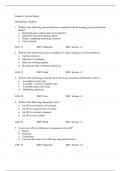Exam (elaborations)
Test Bank for Accounting Information Systems: Thinking, Development, and Evaluation Version 1.0 by Robyn L. Raschke
- Course
- Institution
Test Bank for Accounting Information Systems: Thinking, Development, and Evaluation Version 1.0 V1.0 by Robyn L. Raschke, John A. Schatzel. Full Chapters test bank are included - Chapter 1 - 15 Chapter 1: System Basics Chapter 2: AIS Structure and the Flow of Information Chapter 3: The Data An...
[Show more]



